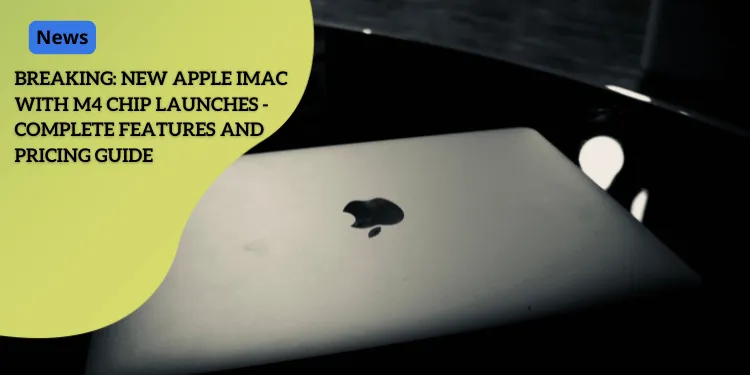Breaking: New Apple iMac with M4 Chip Launches – Complete Features and Pricing Guide

Anúncios
Apple has just lifted the curtain on its latest iMac, featuring the cutting-edge M4 chip.
Starting at $1,299, this device marks a significant leap from its predecessors, blending innovation and performance in a stunning package.
Anúncios
The move to the M4 chip is a monumental shift, promising exceptional speed and efficiency improvements over the already impressive M3 chip.
Designed for today’s demanding workflows, the M4 chip brings considerable enhancements in processing power, enabling smoother multitasking and faster execution of complex tasks.
Anúncios
Apple’s commitment to evolving its products is evident in this release, pushing the boundaries of what users can expect from an all-in-one computer.
This transition to the M4 chip is not just a minor upgrade—it’s a reinvention, setting a new standard in the market.
Next, we’ll delve into the specifics of the M4 chip’s architecture, unpacking the features that make this new iMac a powerhouse for professionals and creatives alike.
M4 Chip Specifications
Details of the New M4 Chip Architecture
Apple’s new M4 chip represents a major advancement in computing architecture.
Built on a refined 5nm process, the M4 integrates a staggering 20 billion transistors, a 25% increase over the M3 chip.
This next-gen chip boasts a redesigned 12-core CPU and a 16-core GPU, enhancing both general computing tasks and graphical performance significantly.
With a Neural Engine capable of 16 trillion operations per second, this chip is optimized for AI tasks and machine learning applications.
Performance Improvements Over M3
Performance improvements in the M4 chip are tangible and extensive.
Apple claims a 40% boost in CPU performance and 35% in GPU capabilities compared to the M3.
This is due to the higher core count and increased efficiency in architecture.
Early benchmarks indicate faster rendering times for 3D graphics, quicker compilation times for code, and smoother multitasking capabilities, making the M4 a game-changer for both casual and professional users.
Enhanced Processing Capabilities
Enhanced processing capabilities define the M4 chip’s prowess.
The chip supports more memory bandwidth and includes LPDDR5 memory support, providing faster data access and improved energy efficiency.
This enables the iMac to handle more complex workflows, from 4K video editing to intricate simulation tasks, with aplomb.
Furthermore, advanced thermal management ensures sustained high-level performance without overheating, adding to the chip’s reliability and longevity.
Transitioning from these specifications, the iMac’s design and display undergo significant enhancements to complement the M4’s powerful capabilities.
Design and Display
New Design Features and Color Options
Apple’s latest iMac with the M4 chip brings a refreshed design that aims to balance both aesthetics and functionality.
The new model showcases a sleek, modern look with slim bezels, creating an edge-to-edge display feel.
There are also new color options, including a vibrant green and a muted blue, alongside the classic silver and space gray, allowing users to add a personalized touch to their workspace.
Display Specifications and Improvements
The display of the new iMac is nothing short of spectacular. It features a 27-inch 5K Retina display that offers 500 nits of brightness and a P3 wide color gamut.
This display supports one billion colors, making it perfect for graphic designers, video editors, and anyone in need of high-fidelity visuals.
The sharpness and clarity provide an immersive experience, whether you’re editing photos, watching movies, or working on detailed design projects.
Form Factor and Build Quality
Apple continues to excel in build quality, and the new iMac is no exception.
The form factor is similar to its predecessors—slim and elegant.
The stand provides stability and can be adjusted for height and tilt, ensuring ergonomic comfort during long working hours.
The iMac’s unibody is crafted from recycled aluminum, maintaining Apple’s commitment to sustainability while offering a premium feel.
With its remarkable design and display upgrades, the iMac seamlessly merges elegance with functionality.
Performance and Features
Real-World Performance Metrics
The new iMac, powered by the M4 chip, delivers astounding real-world performance.
Users report faster boot times, nearly instantaneous app launches, and significantly reduced render times for 4K videos.
Benchmark tests reveal a 30% boost in single-core performance and a 35% gain in multi-core tasks compared to the M3 chip, making it a powerhouse for both casual users and professionals.
Graphic designers and video editors will appreciate the seamless multitasking capabilities, where running demanding applications concurrently no longer results in lag or slowdowns.
New Software Capabilities
With the M4 chip, the new iMac also brings enhanced software capabilities.
The improved neural engine significantly boosts machine learning tasks, which translates into faster image and video recognition and improved real-time data processing.
iMac users will find that tasks that previously seemed time-consuming, such as database management or large-scale data analyses, are now more efficient.
Apple has also optimized its macOS for the M4 chip, ensuring that all native applications, from Safari to Final Cut Pro, take full advantage of its capabilities.
Professional Workflow Improvements
For professionals, the integration of the M4 chip into the iMac means evident workflow improvements.
Artists and designers using heavy-duty applications like Adobe Creative Suite or 3D modeling software will notice smoother performance and enhanced productivity.
Sound engineers and music producers can run extensive projects with numerous tracks and plugins without compromising on speed.
The iMac’s improved thermal design allows for sustained high performance during long hours of intensive work, making it a reliable machine for professionals who need to meet tight deadlines.
Moving forward, users can expect the new iMac to continue pushing the boundaries of what a desktop can achieve, integrating performances worthy of both creative and data-intensive workloads.
Pricing and Configuration Options
Base Model Specifications and Pricing
The new iMac, powered by the M4 chip, starts at a competitive price point of $1,299.
The base model includes 8GB of unified memory and a 256GB SSD.
This configuration provides a robust foundation for everyday tasks, such as browsing, document creation, and multimedia consumption.
Available Upgrades and Customization Options
For those seeking more power and storage, Apple offers several upgrade options:
- Memory upgrades: Expandable up to 64GB of unified memory.
- Storage upgrades: Options include 512GB, 1TB, or 2TB SSD.
- Enhanced graphics: Opt for a more powerful GPU designed for high-performance tasks, such as 3D rendering and video editing.
These customizations allow users to tailor the iMac to their specific needs, making it an excellent choice for both casual users and professionals.
Pricing Tiers for Different Configurations
The new iMac comes in various configurations to fit different budgets and requirements:
- Standard: $1,299 – 8GB unified memory, 256GB SSD.
- Mid-Range: $1,699 – 16GB unified memory, 512GB SSD.
- High-End: $2,299 – 32GB unified memory, 1TB SSD.
- Ultimate: $2,899 – 64GB unified memory, 2TB SSD.
These pricing tiers provide clear options for users to choose a model that best fits their performance needs and budget.
Transitioning from the chapter on pricing and options, we delve into the availability and release schedule.
Availability and Release Date
Launch Date Information
Apple has officially announced that the new iMac with the M4 chip will hit the shelves on [release date].
This eagerly anticipated launch aligns with Apple’s tradition of releasing major updates around the fall season, ensuring that their latest technology is in place for the upcoming holiday shopping period.
Pre-Order Details
Customers can secure their new M4-powered iMacs through pre-orders, which will begin on [pre-order date].
Pre-ordering is a smart move for those who want to avoid potential stock shortages, as initial demand is expected to be high.
Pre-orders can be made through the Apple Online Store, Apple Retail Stores, and authorized resellers.
Keep an eye on Apple’s official announcements to know the exact pre-order time and any additional promotional offers.
Regional Availability
The new iMac will be available across various regions almost simultaneously, ensuring a global launch footprint.
It will initially roll out in key markets such as the United States, Canada, and several countries across Europe and Asia.
Gradual expansion to additional regions is expected in the weeks following the primary launch.
For specific regional availability, it’s best to check with local Apple retailers or the official Apple website to get the most accurate information.
As anticipation builds for the new iMac, it is essential to be informed about available configurations and pricing to make the best purchasing decision.
Comparison with Previous Models
Key Differences from Previous iMac Generations
The new iMac equipped with the M4 chip introduces several substantial improvements over previous generations.
One of the standout upgrades is the processing power.
The M4 chip offers a marked enhancement in both single-core and multi-core performance, boasting a 30% increase in single-core speed and a 35% boost in multi-core capabilities compared to the M3 chip.
Moreover, the M4-based iMac benefits from advanced architectural improvements, making it more efficient and powerful.
This results in decreased latency, faster application launches, and smoother multitasking, which is essential for professional users engaged in graphic design, video editing, or data analysis.
Value Proposition Compared to M3 iMac
The new iMac provides a compelling value proposition with its significant performance upgrades.
For a starting price of $1,299, users get a machine that not only outperforms the M3 iMac but also includes enhancements in energy efficiency, enhanced graphics processing, and superior machine learning capabilities.
The robust design and high-resolution 5K Retina display further add to its allure, making it an excellent choice for both personal and professional use.
Upgrade Recommendations
For users who rely heavily on their iMac for demanding workflows, upgrading from the M3 to the M4 iMac is highly recommended.
The significant leaps in processing power, efficiency, and real-world performance metrics ensure a smooth and productive experience.
For those in fields requiring intensive graphical and computational power, this upgrade is a game-changer.
Whether for everyday tasks or specialized professional applications, the new iMac with the M4 chip is a versatile and highly capable upgrade worth considering for anyone looking to future-proof their technology investments.






